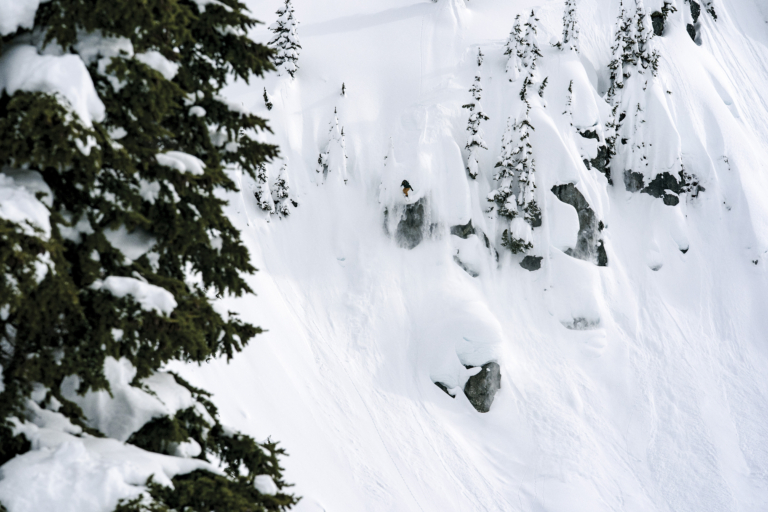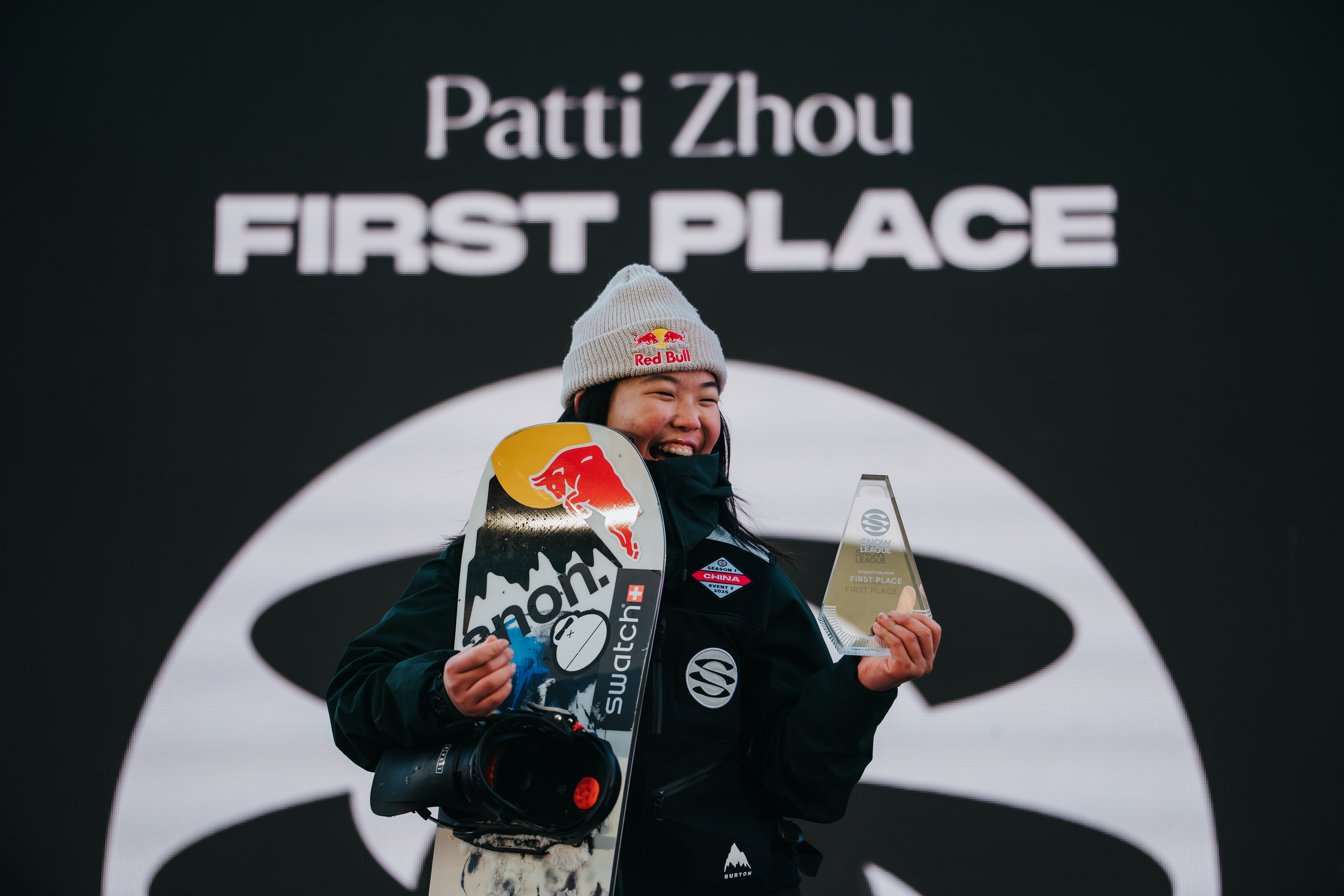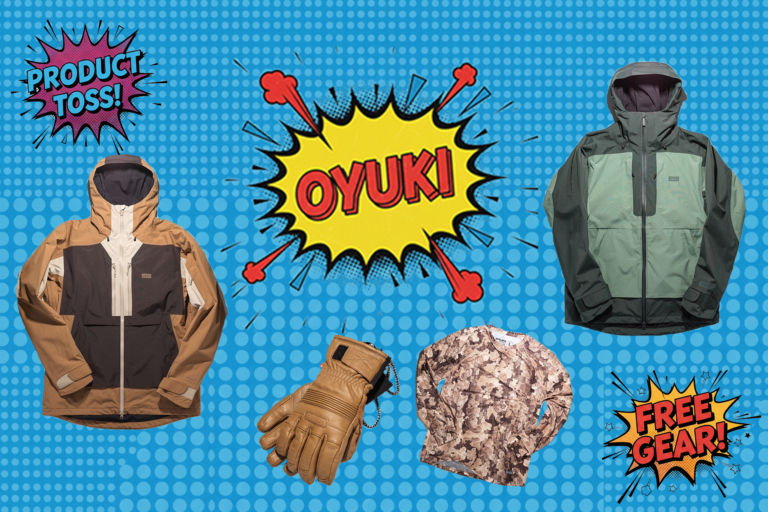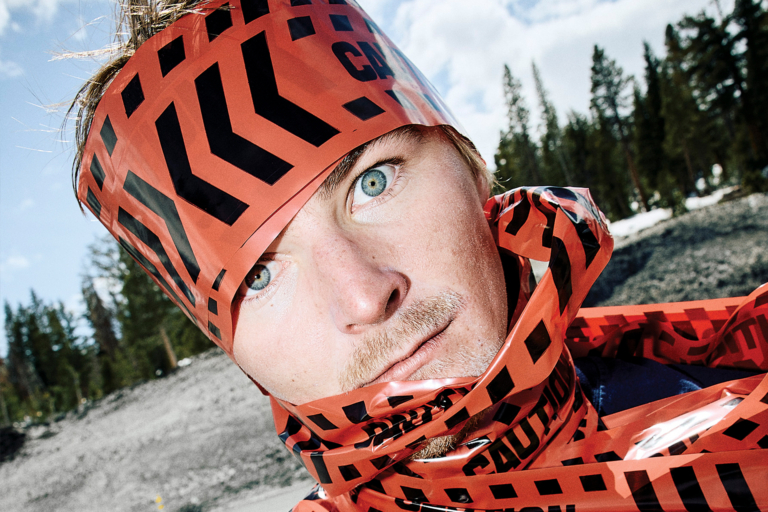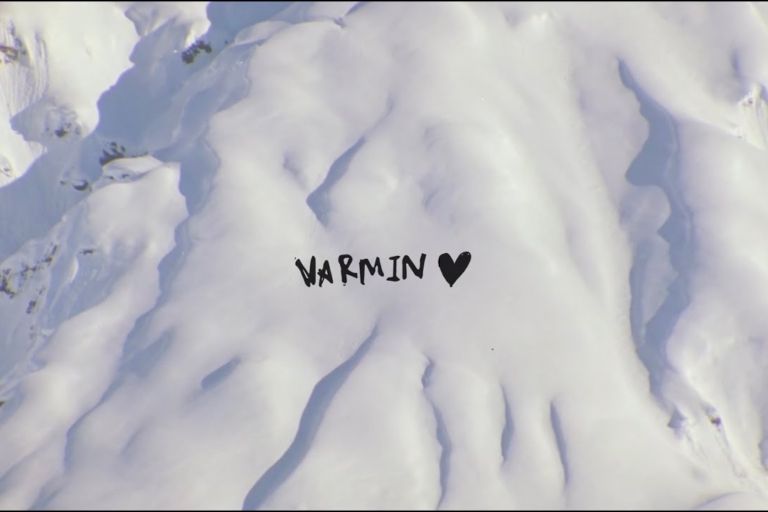When you think of a board designer living the island life, you probably think of a surfboard shaper, but that is not the case for Michael Chilton. Chilton recently moved to Vashon Island, just west of Seattle, when office life slowed down during the pandemic, and his area of specialty is snowboards. You might be familiar with his body of work if you have strapped into any board with “Ride” stamped across it over the past decade. As the senior product design engineer at Ride Snowboards, Chilton has had his hand on every board that has come out of the brand since 2013.
A lifelong snowboarder, Chilton studied mechanical engineering in Reno and product design in Boulder, leading him into working with renewable energy products before finding his way back to his original plan, designing boards. He is the brains behind the PIG line, and to be honest, can explain how boards work better than most people we know. We decided to hop onto island time and have a long conversation with him about board design, inspiration, and the original name of the Warpig, before he had to hop on the ferry to get to work. Enjoy. – Mark Clavin

Where are you at?
I’m up in Seattle area, but I live on Vashon.
That’s a big island, right?
Yeah, yeah.
How long have you been there?
My wife and I moved out here last fall. We went and bought a house in the summer. And now we have a baby, so doing the whole thing.
How far is the commute to ride?
It’s actually the same commute to downtown as it was from north end of Seattle.
Are storms ever too bad to get over to the mainland? Or the ferry runs all the time?
They run pretty well. They’re usually late, if anything, so you’re going to have to take that into consideration. But I don’t think they really shut down for storms. The tide is the only thing that fucks it up. But it’s fun taking a 20-minute cruise into town.
Do you ever find inspiration on the cruise over?
I won’t say no. There’s definitely some level of calm that comes with it. But yeah, I don’t really go into the office that much lately, just because office is a weird time right now and we don’t have childcare, so baby care is the priority.
Oh, yeah, for sure.
I haven’t taken that boat too often, but when I do, it’s relaxing.
All right. So, you are the brains behind the WARPIG, correct?
Yeah.
Where are you originally from?
Originally from South Lake Tahoe.
When did you start snowboarding?
Started in sixth or seventh grade, so like when I was 13 or 14.

What was your first board?
My first board was actually a K2 Dart. I pulled it out of my parents’ shed a couple of years ago. The stomp pad was actually the coolest thing about it, I thought. It’s that thick quarter-inch neoprine-type shit, like a wetsuit stuck to my board.
I think I was in eighth grade when I actually started riding for K2. My name was in their catalog for two or three years. I was just a flow kid. I didn’t know what I was doing, doing USASA stuff and trying to live a dream that I thought was going to have to happen. Everybody was so cool, and it was awesome just not having to buy shit at the ski swap every year. That was the coolest thing. It was just Christmas every year.
And then you went to school for what?
I went to school for mechanical engineering in Reno, and then I did grad school in Boulder after that for mechanical engineering with a focus in product design.
All with the intention of working in snowboarding?
When I first went into engineering, my initial thought was, “I want to redesign all my snowboard products.” That’s why I went into engineering. And then sophomore year, I had a professor talk me out of it for whatever reason. So I got into doing more renewable energy-focused engineering, and I worked for the power company in Nevada, doing renewable energy development for three years or so. When I graduated, I actually worked for a startup solar company. Then that started getting really dull and it wasn’t what I thought it was going to be. I actually more or less tricked them into letting me move to Colorado to start grad school for the other thing that I wanted to do, because I basically felt like, “I don’t want to do this anymore. This is just a money-making scheme and I’m not passionate about it.” I didn’t really like basically just being a data monkey.
In grad school, you studied design of snowboard products?
It was a product design-focused engineering program. So, usually, when you go through grad school and engineering, you’re not really picking much of a focus for a master’s degree.
How long have you been working at Ride?
This will be my ninth year at Ride.
Wow, coming up on a decade. How many boards have you been integral in either designing, redesigning, or taking steps and advancing them? Is your fingerprint on every single board in the line?
I’m the only engineer for the Ride board line. There’s only ever been one, even before my time. So at this point, every board in the line is something I’ve designed. There are been a few that have been pushed out of the line since then, as well.
Wow. That’s crazy.
Yeah. I think I came to that last year or the year before. It was a weird realization to know that everything in there was mine now.
When you start shaping a board, how do you start in the design process?
Well, it’s helpful for boards because I don’t have to think too much in 3D. Everything starts as a 2D sketch. You’re just coming up with that 2D profile. Usually, what I’ll do is I’ll try to find a few different reference shapes and I pull that from a million different places. Surfboards, obviously, are a very easy start. Skateboards are tricky to pull things from because they’re not really the same proportion. A lot of times, I’ll take top views of sports cars and try to find the edges of how the tails of the sports car are coming off, try to find unique ways that you create a boundary surface to a point.
There’s only so many ways you can do a round one. There are only so many ways you can do a blunted one. And finding top views of boats, cars, shoes, all those things are influences how I can create that footprint shape and how I can bring something out that’s a little bit different. It usually starts by just trying to amass a bunch of different inspiration and then pulling that into our CAD modeling software. In the software, everything has to be dimensioned and you can’t just make a free-wheel sketch and expect it to be built into tooling and all these things down the road. For me, at least, I need to dimension and control it, which is, again, the opposite of a creative mind, so…
If you stretched a shoe out, what would be the best type to use as a snowboard shape: a skate shoe, a dress shoe, a soccer cleat, or a sandal?
I’m trying to remember. I haven’t used shoes in the last few rounds of things, but I know that the last time I was really looking at them, a lot of designer women’s shoes have really unique toe boxes. I can show you the shoes I have on. I don’t know. But you can pull a shape from that in any way. Obviously, with shoes, they’re always going to be asym, but you can pull at least that corner and get a sense for how something’s going to pull over.
[When looking for shapes inspiration,] I’m not copying a shoe one-to-one. It’s really just seeing “Oh, okay, I can build a straighter line here and curve that in there,” and when you build that into CAD software, you see that “if I have a straight line here, it’s going to look like it’s inflecting, so I need to round that off a bit.” I remember having Tanner [McCarty] and Jim [Linnberg] just stand over these footprint cutouts like, “Yeah, that looks really good.”
That’s pretty sick.
There’s a lot of that. I know how to make a snowboard ride really well because I’ve got a really good understanding now of how sidecut and flex affect everything. That was the biggest thing to get under my skin, figuring out how to do that. But the hardest part is making a tip shape that looks good that will actually stand the test of a couple handful of seasons and not look dated after a while. That takes a lot of refinement and getting in front of people’s eyes and bigger groups of people being like, “That looks stupid. I don’t like how that is.” And seeing it in real life, too.
What about just a classic shape? Round nose and round tail. Seems like they got it pretty right.
I don’t know. I mean, when I talk classic shape, I’m thinking just a round tip and tail, but when a lot of people think “classic shape,” they think radial sidecut, big camber, like “that was how it used to be done; those are real snowboards.” And if you go and ride one of those boards now, compared to one of our new camber boards, they are infinitely worse. There is no way you could go ride an OG LaMar—I’m trying to think of the last big camber board I saw, something that had a ton of camber, radial sidecut, stiff as a brick—and then you ride that with our new Benchwarmer that has less than 10mm of camber, really good flex, a progressive sidecut built off of three radii with a bunch of different other tricks in the sidecut that I program in there, it just rides so much better.
I don’t think there’s any way you could compare old boards to new boards, at least the way that a lot of people make them now. Progressive sidecut makes a board ride infinitely better than just a radial one. Radial’s just an easy way to draft something up. Yeah, it’s harder to build out a parametric design that accommodates three radii building on themselves and naturally—
Could you explain progressive and radial cuts in very layman’s terms?
So, radial sidecut is just a single radius. That doesn’t define the radius of your turn by any means. The radius and the sidecut are essentially just, if you took the side of the board and you drew that as a full circle, that’s the radius. You’re just basically taking a slice of it, so it’s really an arm’s length of a radius of the circle. Normal, old snowboards were all radial because it’s a really simple way to just draw a sidecut. I don’t know when it started becoming more normal, but modern snowboards typically use a progressive sidecut, which is a blend of three to four different radii. For Ride, I use three radii for most boards.
That is pretty simple. The three radii means the three arcs.
Progressive sidecut, as I understand it, is a wider sidecut at the tip and tail, with a narrower side cut in the middle. What that does, is it allows you to have a lot of deep progression in the middle of the turn, but a really easy and predictable initiation and exit from the turn. Essentially, if you think a wider sidecut means less aggressive turn, deeper sidecut is a more aggressive turn shape.
We also have other boards in the line that flip that around and have a really tight sidecut at the tip and tail and a wider sidecut in the middle. Those are typically for boards that are fairly stiff underfoot, but the way the sidecut is designed, once you get that on snow, it’ll just push itself on edge really easy. It almost turns itself.
Like a Tesla.
I learned about sidecut by spending a lot of time looking at boards sideways on a table: try to get eye-level with the table, put the board down sideways, and put it on the edge at an angle, then flex the board down the middle. When you’re in a turn, your board is in a flexed arc and the sidecut is essentially determining how much the board’s able to flex at any point along its length. A deeper sidecut allows it to flex more, which allows you to get a deeper turn. Shallower sidecut: flex less, less of a turn. And if you progress that sidecut depth in how it’s transitioning, that adjusts how the board will flex at different points in its length.
The effectiveness of the flex becomes more pinpointed as opposed to just one continuous radial sidecut.
Yeah. I think, from that, you’re able to get a much more adjustable turn-shape because your board’s not designed for a single arc, it’s designed to peak, progress, and be able to adjust and accommodate to, “I want to put more effort in the back foot.” It’s going to snap through that a little bit easier and just feel a lot more controlled and supportive through it.
And all Ride boards have that now?
They all have some derivative of that. I’ve taken up sidecut as the thing that I like to define in how I design a board, because I found, in my really first few years, that sidecut affected so much of how a board rode. So I made something that I wanted to focus on and really improve and perfect. The three radii sidecut is our bread and butter. Then we have this elliptical radial sidecut that’s on the Commissioner—really tight ellipses at the tip and tail and a really wide radius in the middle that allows you to let the board turn itself, but still get a lot of acceleration when you’re not trying to turn a lot.
And now we have some iterations with straight lines in the sidecut. The MTNPIG has a straight line coming tangential off the radius in the tail, and what that does is basically prevents you from overturning, because it’ll prevent the board from over-flexing. It locks it out, to a point. The MTNPIG is crazy because you have that really fun turn initiation and turn progression, and then, when you get on the backend of your turn, you can just sit on your back foot and it’ll rail on the back and accelerate off, and you won’t have that snap that you usually get on the back end if you’re a little too heavy on there.
And now that we have that split tail in there, the thing is a whole different animal. We use a similar kind of sidecut than that one on the Burnout but with a little bit different approach, because what I found was that not only do you get that power off tip and tail, but you get flatbase stability really easily. The Burnout is going to hook you into a turn super hard. So, it’s really predictive and easy to roll up to a rail or jump without feeling like it’s going to hook on you. We designed it so you get this really wide platform underfoot to prevent you from slipping out on your edge when you come off on a rail.

So as far as parts of the board that affect your ride the most in your mind, you would put sidecut first?
Yeah. Sidecut definitely the first.
What would be the next two?
I think it goes sidecut, camber, and flex, because camber can make something ride so differently, regardless of what the core is. We did a lot of testing back and forth with different camber lines to try to get a sense of how the board is affected by adding little bits of rocker in the tip and tail, how you can perfect adding camber in the middle, and different ways you create a camber shape. Camber, next to sidecut, really affects a lot, and you can really finetune things through that.
The hard part with camber is that it is a very difficult thing to control in production because the way that snowboards are made, they’re constantly expanding and contracting. As things cool down, you lose camber. As you sand, you lose camber. It’s a constant battle of trying to maintain that tolerance. So, it’s something that affects a lot, but we have to build a lot of assumptions in there as well.
So no matter how dialed in the process is, every board is technically a one of one?
No matter what happens, there’s going to be a slight difference based on who’s molding that board, because it changes. There are so many little pieces. That’s one thing I didn’t recognize before I started—there are hundreds of parts that go into a snowboard, and almost all of them are handmade. There are really not that many places that you can automate any of those processes. A large part of my job is working with the factory, developing processes, figuring out ways to reduce that margin of error, and basically come up with new processes to make a board model repeatedly without problems. There is a lot of variation, but we’ve gone through so much work to control that. There’s very few people, I think, in the world that would be able to feel that variation on snow.
I mean, the same goes for surfboards, really, to that end.
100%. Surfboards even more so because it’s such a handmade process. No matter how much you scale it, each board is unique. And that’s the hardest part of my job, taking something that is invariably unique and trying to make it as consistent as possible.
In my eyes, that just makes your own board more valuable. It’s its own board. Your riding will slightly change it over time.
We’re the only industry that makes composite products that are designed to constantly be flexing. Surfboards weren’t really flexing all that much until the last few years when they started building sidecut-type stuff. Skateboards aren’t really intended to flex. Skis and snowboards are constantly flexing. And that’s the only way you get a turn; the board has to flex. If you made a board stiff as a brick, it wouldn’t do anything.
Yeah, wow.
You could ride a board without flex in powder because you can ride a door through powder, but groomers, you couldn’t do anything with it. So, it’s really bizarre that we’re making something that has to constantly bend and flex. The newer technologies and newer processes that have come in the industry in the last ten or fifteen years are making boards that can bend and flex for years and years and not blow apart. Our standards are so high that we want things to stand the test of time, so you’re not buying a new board every year, even though, business-wise that would probably help. But we don’t want you to necessarily throw something out every year. We want something to last so that it can go into a thrift store, for example, and be constantly reused.
How did you come up with the idea for the WARPIG and the PIG line?
I’d ridden other short boards—at the time K2 had the Cool Bean, Burton had a Nug, and I was like, “These are kind of fun.” But when I got on the Salomon Derby, I was like, “This thing is so fun.” I had never felt a short board that was really quick at turning. Ao then I wanted build something that had that same feeling in mind. I don’t know how they designed that board, but I went from the ground up and wanted to figure out how to make a short, wide board that was a race board. I wanted to be able to carve like crazy. You can make a powder board do anything or you can make a board for powder in any way, but I wanted a short, wide board that was intended to be really fast, really easy to turn, really quick edge-to-edge, and feel more like your toss-around board. The idea was to have something that was not necessarily your everyday board, but your board you always had in your car in case conditions got crumby and you wanted to have a good day. One of the things I remember tossing around with Tanner at the time was those Catch Surf foamies that were coming out. We just want to make that dumb, fun board that you’re going to have in the back of your car all the time. Like, “Oh, it’s raining. Fuck it, I’ll ride this thing and have a great time, turn my day around.” Testing it out with the WARPIG, the way that sidecut worked on a really wide, short board made it just so fun and so quick. It took away all the negative aspects of wide boards.
Just the quick edge-to-edge aspect.
Yeah. I always get shit for this, but my code name for the model before it became a final product was The Wiggle Stick. And for the longest time, I thought that was the coolest name. I was like, “It’s going to be called The Wiggle Stick. Everyone’s going to love this thing. It’s so fun because you’re just wiggling around everywhere.” And then I think the first time I told that name to Jim and Theodore, it was like, “No. That’s not happening. Don’t put that anywhere anymore.” I don’t think it would’ve been as successful if it was called The Wiggle Stick, honestly. I think there is a lot of value in how the board’s named. And I don’t think it would’ve caught on to the same level. Maybe over more time, but not as quick as it did.
And then, after its success and you start branching out into different models. Why make so many iterations of it?
So, when the WARPIG first came out, the first year there was a small and a large. And then we expanded into more sizes because more people wanted to ride it. So, we made more sizes. Then it was like, “Oh, well, we need a freestyle one because we can’t have Brandon Davis riding a WARPIG in fucking World Cup slopestyles every year, so we’ll make him a twin version.” So, I made the TWINPIG. And then it was like, “Well, now people want more of a WARPIG that they can really go super fast on.” So, then we made the SUPERPIG.
And the MTNPIG came in there, as well, because people don’t want to always ride short and fat, they sometimes want something that is more standard length but still in that thrashy, wild way. The MTNPIG is our interpretation of a Gentemstick on acid. We wanted to make something that could make big, wide-arcing turns but was a very different kind of concept. And the MTNPIG has evolved even further to where it is now, still in that realm but just a lot more fun. So, yeah, the initial idea created this whole line of boards that are sort of purpose-driven, but that purpose is essentially to just go out and hit side hits, rip around, thrash around. They are purpose-driven to not have a real purpose, in a weird, loopy sense.
Yeah. You’re now making PIGS that are more specified for conditions, but at the same time, they all still have the same heart in that they are just there to make whatever you’re going to be riding the most fun with the most ease.
Yeah, and it’s crazy. I ride the small WARPIG, a 148, which is the size of the first snowboard I had, which is weird. But I can ride that board every day. I can take that board to Japan.
How tall are you?
I’m 5’11” and I’m about 170. I usually ride a 159, but I can ride that 148 in anything and have the best time. There are very few moments where I’m like, “Man, I wish I had more board.” And in those few moments, I just pull out a Commissioner and I’m like, “This is what I need for that small amount of time to go 500 miles an hour.”
Now, after creating a full line that is very successful, are you ready to move past the WARPIG or…?
So, that was where we ended up the last year. This year, we had a big project to redesign the PIG line. I went through a lot of different shapes to try to figure out how we could evolve things. And really, every concept that we came up with ended up looking like other brands’ boards that were essentially built to mimic ours. So, we ended up not changing the tip shapes. After improving the sidecut on the MTNPIG and the TWINPIG, the WARPIG stayed the same.
But what we did to really revamp that whole line was create the Slim Wall concept which is a constant-thickness sidewall that is under 1.5mm thick. It’s still urethane but it has a full 3D structure that comes down over the core and to the sidewall. We designed that to take weight out, use materials more efficiently, and have less material along the edge so you’re faster on edge—so there’s less friction there. But at the same time, we wanted to create a visual 3D sidewall that was as durable or more durable than our existing, just regular urethane.
That took almost two and a half years of development and at least 100 board prototypes to get through in testing before we came up with the final version. I’m really proud of that tech because it took so long to get to where it is and there was a lot of trial and error and a lot of redesigning that went into it, especially upfront and in the factory.
Looking at other board companies, is there a board that you wish you would’ve designed at any point throughout history? Any board you’ve ever seen, is there anything you were like, “Man, I wish I would’ve done that one?”
I think the boards that I’m most excited by these days are Korua’s, just because their vibe is very much how I like to snowboard.
Now that you’re a new father, are you going to create a child-sized WARPIG or improve the children’s snowboard?
I actually just had the conversation with our boot manager, Troy, who also is a new father. We were brainstorming, talking about “yeah, this kids’ board sucks for kids, actually.” Now that we have kids, we understand what they want.
So, we might see some groundbreaking kid tech coming out from RIDE?
Oh, yeah. Firsthand experience now, we’re like, ” Okay, now we know what we need.”

